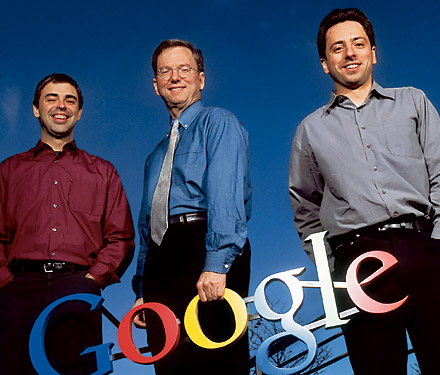
We all think of Google as innovative and fun, but do we ever stop and think how it became that way? Founders Sergey Brin and Larry Page started the small company in 1998 and since then has consistently made Fortune magazine's list of best companies to work for. Though many points made here could also support a discussion on how Google fosters creativity and innovation, I will assume that creativity is a byproduct of the culture.
According to Schein, culture is “the assumption that underlie the values and determine not only behavior patterns, but also such visible artifacts as architecture, office layout, dress codes, and so on.” Google’s culture is based on sharing ideas and opinions in order to accomplish their mission of organizing the world’s information and make it universally accessible and useful. Clearly they pride themselves on unorthodox practices, such as no dress codes or strict hours. Free food at the Googleplex café and whiteboards in the hallways further instill the idea of open communication. Googlers can also join interest groups and partake in the onsite massage parlor, salon and doctor’s office. They also created the office space to have very few solo offices, fitness equipment, and games. Probably the most famous perk it the 20% rule, in which 20% of an employee’s time must be spent on a project of personal interests.
Sergey and Larry have done a terrific job in defining and upholding the culture by recruiting the right people to fit their ideas. How often do you hear about a company with the position of Chief Culture Officer? Google does, and she works with employees around the world to figure out ways to maintain and enhance and develop Google’s culture and how to keep the core values they had in the very beginning--a flat organization. Every Friday is TGIF in which employees are allowed to ask the founders anything and everything.
Following Schein’s Problems of Internal Integration, we can clearly see Google’s culture in their Code of Conduct (http://investor.google.com/corporate/code-of-conduct.html). Language is seen through the use of Googlers, Googleplex, Nooglers, etc. Boundaries: Everyone is in, unless you do something “evil” i.e. personal investments, outside employment and inventions, accepting gifts and other business courtesies. Intimacy: personal relationships at work should be avoided. Other examples can be found embedded in their expanded code.
The next phase in shaping culture would have to be when Larry and Sergey decide to pass the torch and step back from the organization. They will have to choose carefully who will replace them position wise as well as culturally to avoid the case we saw with Carly Fiorina.



Great post! I believe Google will face a culture challenge as the company ages. As founders grow older, their influence weakens, as we saw in the case with Carly Fiorina. As their influence lessens, this opens the door the culture to turn into routines and policy.
ReplyDeleteI also wonder if any of the staff at Google are unhappy and just afraid to leave as they may feel that they wont survive any where else. The culture could possibly have a negative effect on employees by placing them in a position of infantry. If they are not afraid of of leaving they may not want to disrupt the "groupthink" culture that Google has established.
That is very true. I did a search (on google haha) and of course there are some negative comments out there, that's inevitable. But reading the article on SAS for class I found myself comparing them throughout the article. While SAS encourages employees to not take work home, Google employees are working 24/7 whether from home or at the Googleplex.
ReplyDeleteI do not doubt that unhappy employees decide to stay just because of the culture.